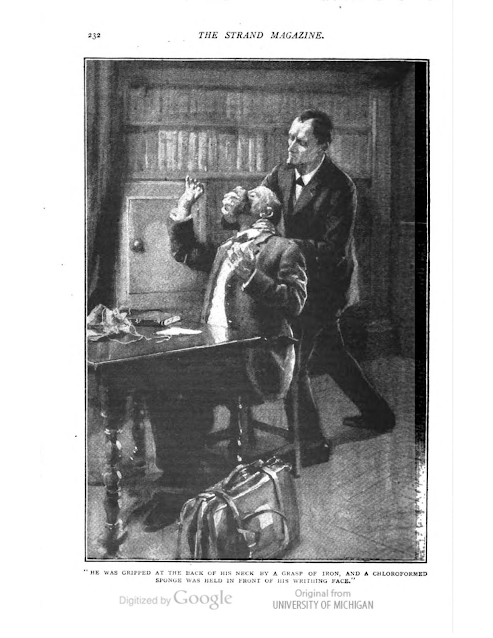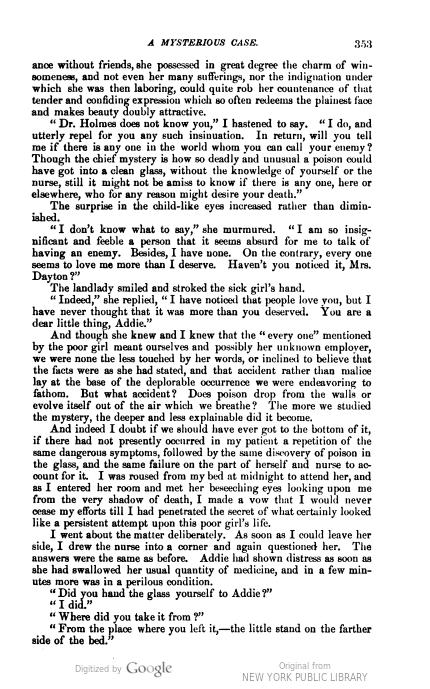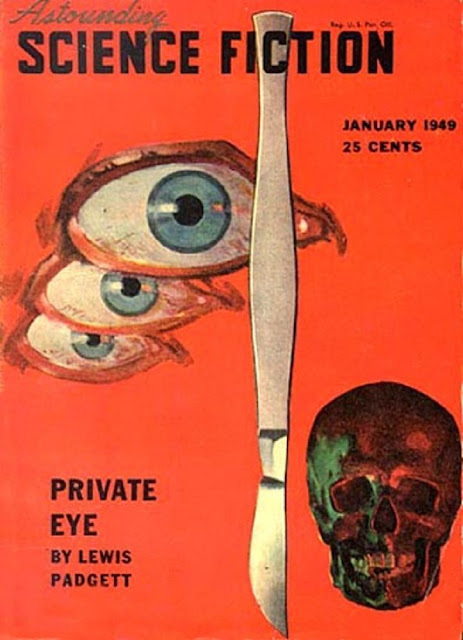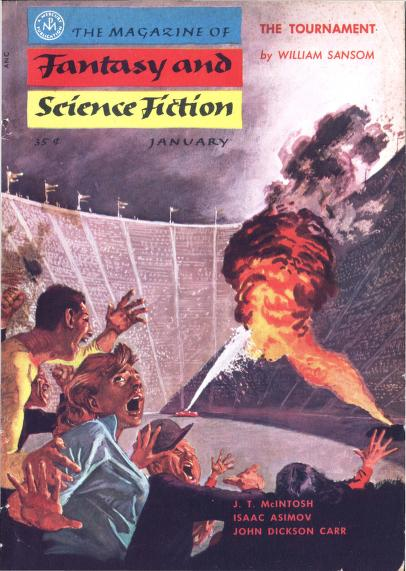Online links added to the "Resources" section (HERE) for these stories: "A Kiss for Belinda," "If You Want to Get Killed," "The Man Who Lost His Taste," "Goodbye, Stranger," and "Death by Drowning?"
Sunday, October 29, 2023
Saturday, October 28, 2023
UPDATE: Lawrence G. Blochman's "Calendar Girl"
A couple of accessible story links added in the "Resources" section (HERE) for "The Man with the Blue Ears" and EQMM's reprint of "In Vino Veritas," the latter being Blochman's only Dr. Frank Belling story.
"It Was a Baffling Crime . . . In Fact, an Apparently Impossible One"
"The Strangled Bride."
By Ellery Queen (1905-71 and 1905-82).
Illustrated by Louis Glanzman (1922-2013; Wikipedia HERE).
First appearance: The American Weekly, June 6, 1954.
Collected in Ellery Queen's International Case Book (1964; Ellery Queen megasite HERE) and retitled as "The Strangled Bride of Oran."
Short short short story (2 pages).
"To protect persons involved, Mr. Queen has concealed key identities under fictitious names."
If you recall Holmes's most famous axiom then you should be able to get there even before M. Ficel . . .
Principal characters:
~ Clara Edgerton, the victim:
". . . had been sweet and gentle, a perfect lady, untouched by scandal or intrigue, unadventurous, without an enemy."
~ Louis Duperie:
"Because of his wounds, the young veteran settled in Algeria after the war, opening a modest souvenir shop for tourists in the Oran hotel where Clara Edgerton was employed."
~ The prefect of police:
"The most unusual crime we of the Oran police have ever investigated?"
~ Ficel of the Surete:
"But this case is of the utmost simplicity."
References and resources:
- "the Oran police":
The site of a major military operation in World War II: "Oran (Arabic: وَهران, romanized: Wahrān) is a major coastal city located in the northwest of Algeria. It is considered the second most important city of Algeria, after the capital, Algiers, because of its population and commercial, industrial and cultural importance. It is 432 km (268 mi) west-southwest from Algiers. The total population of the city was 803,329 in 2008, while the metropolitan area has a population of approximately 1,500,000, making it the second-largest city in Algeria." (Wikipedia HERE.)
- "a dark picture of Berber savagery or some burnoosed Arab's treachery":
Berbers are the very definition of cultural diversity: "Berbers (Arabic: بربر) or the Berber peoples, also called by their contemporary self-name Amazigh (/æməˈzɪɡ/) or Imazighen (Berber languages: ⵉⵎⴰⵣⵉⵖⵏ, ⵎⵣⵗⵏ, romanized: Imaziɣen; singular: Amaziɣ, ⴰⵎⴰⵣⵉⵖ ⵎⵣⵗ; Arabic: أمازيغ), are a diverse grouping of distinct ethnic groups indigenous to North Africa who predate the arrival of Arabs in the Arab migrations to the Maghreb.Their main connections are identified by their usage of Berber languages, most of them mutually unintelligible, which are part of the Afroasiatic language family. They are indigenous to the Maghreb region of North Africa, where they live in scattered communities across parts of Morocco, Algeria, Libya, and to a lesser extent Tunisia, Mauritania, northern Mali and northern Niger." (Wikipedia HERE.)
- "a Lyonnais of honest bourgeois stock who had served bravely at Verdun and the Somme":
"Lyonnais now often simply refers to the area around the city of Lyon." (Wikipedia HERE).
"Verdun": "The Battle of Verdun (French: Bataille de Verdun; German: Schlacht um Verdun) was fought from 21 February to 18 December 1916 on the Western Front in France. The battle was the longest of the First World War and took place on the hills north of Verdun-sur-Meuse." (Wikipedia HERE.)
"the Somme": "The Battle of the Somme (French: Bataille de la Somme; German: Schlacht an der Somme), also known as the Somme offensive, was a battle of the First World War fought by the armies of the British Empire and the French Third Republic against the German Empire. It took place between 1 July and 18 November 1916 on both sides of the upper reaches of the river Somme in France. The battle was intended to hasten a victory for the Allies. More than three million men fought in the battle, of whom one million were either wounded or killed, making it one of the deadliest battles in all of human history." (Wikipedia HERE.)
- "no genie had materialized from a bottle":
Superstitions die hard—and some never do: "Jinn (Arabic: جِنّ, jinn) – also romanized as djinn or anglicized as genies – are invisible creatures in early religion in pre-Islamic Arabia and later in Islamic culture and beliefs. Like humans, they are accountable for their deeds and can be either believers (Muslims) or unbelievers (kafir), depending on whether they accept God's guidance." (Wikipedia HERE.)
Genies have been showing up in popular culture for a very long time: "Genies or djinns are supernatural creatures from pre-Islamic and Islamic mythology. They are associated with shapeshifting, possession and madness. In later Western popular representation, they became associated with wish-granting and often live in magic lamps or bottles." (Wikipedia HERE.)
- "the Surete":
A brief compare-and-contrast post about the British vs. the French approaches to crime solving is (HERE).
- "You can see Hugh Marlowe as Ellery Queen on television":
"In 1954, Norvin Productions produced the syndicated series Ellery Queen, Detective with Hugh Marlowe as the title character. Episodes from this series were broadcast on many local American networks and in United Kingdom between 1954 and 1959 under various titles like Mystery is My Business, Crime Detective and New Adventures of Ellery Queen."
(Wikipedia HERE.)
- Our last encounter with EQ before we fell ill concerned his story "The Two-Headed Dog" (HERE).
Unless otherwise noted, all bibliographical data are derived from The FictionMags Index created by William G. Contento & edited by Phil Stephensen-Payne.
~~~~~~~~~~~~~~~~~~~~~~~~~~~~~~~~~~~~~~~~~~~~~~~~~~~~~~~~~~~~~~~~~~~~~~~~~~~~
Tuesday, October 24, 2023
"Of All the Crazy Tricks Fate Had Ever Played on Mortal, This, Surely, Was the Craziest"
"Kid Sheriff."
By Hapsburg Liebe (Charles Haven Liebe, 1880-1957; Pulp Flakes HERE).
First appearance: Argosy, December 1, 1934.
Reprinted in West, March 1941.
Short short short story (5 pages).
Online at Pulp Magazines (HERE; go down to text page 124).
"Six thousand dollars was the bait, and if fake oil stock wouldn't do it, nitro-glycerin would."
A word in your shell-like ear: If you're ever caught red-handed robbing a safe, you'd be well-advised not to address the arresting officer as "you boob" . . .
Main characters:
~ Arthur Q. Dale:
"We'll make the acquaintance of Jonathan Ford—the rich old jigger—and slip the hypo into him before he knows it."
~ Jack B. Morgan:
"And before the kid sheriff knows it. Art, you're a jewel!"
~ Jonathan Ford:
"A few weeks ago I had a chance to buy some oil stock, and almost did."
~ Jimmy Linster:
"My old dad was a sheriff before me, and he taught me things."
~ Bud:
"A few hundred dollars and a couple automatic pistols, Jim."
References and resources:
- "some nitro":
The guy they named all those prestigious prizes after knew this chemical well: "Nitroglycerin was the first practical explosive produced that was stronger than black powder. It was synthesized by the Italian chemist Ascanio Sobrero in 1847, working under Théophile-Jules Pelouze at the University of Turin. Sobrero initially called his discovery pyroglycerine and warned vigorously against its use as an explosive. Nitroglycerin was adopted as a commercially useful explosive by Alfred Nobel, who experimented with safer ways to handle the dangerous compound after his younger brother, Emil Oskar Nobel, and several factory workers were killed in an explosion at the Nobels' armaments factory in 1864 in Heleneborg, Sweden." (Wikipedia HERE.)
- "We used to be experts at cracking cribs":
"(Criminal slang, dated) To break into a house." (Wiktionary HERE).
- FictionMags's list of our author's short fiction output (HERE) runs to nearly three full pages, starting in 1911 and going to 1951. Most of them were of the action, Western, and crime fiction varieties. For more background, consult the Pulp Flakes article about Hapsburg Liebe (HERE).
Unless otherwise noted, all bibliographical data are derived from The FictionMags Index created by William G. Contento & edited by Phil Stephensen-Payne.
~~~~~~~~~~~~~~~~~~~~~~~~~~~~~~~~~~~~~~~~~~~~~~~~~~~~~~~~~~~~~~~~~~~~~~~~~~~~
Monday, October 23, 2023
UPDATE: Leroy Yerxa's "These Shoes Are Killing Me"
Mammoth Detective cover switchout and dead story link deleted (HERE). Unfortunately, we still can't locate that particular issue online.
Unless otherwise noted, all bibliographical data are derived from The FictionMags Index created by William G. Contento & edited by Phil Stephensen-Payne.
~~~~~~~~~~~~~~~~~~~~~~~~~~~~~~~~~~~~~~~~~~~~~~~~~~~~~~~~~~~~~~~~~~~~~~~~~~~~
Saturday, October 21, 2023
A Short Review of "His Last Bow"
Review of "His Last Bow."
Appearance: The Sketch, November 14, 1917.
Online (HERE and below).
This is about oblique as reviews get:
Resources:
- Being a patriot, Sherlock Holmes would naturally support the war effort (in this case, World War One) in whatever ways he could. What survives of the original "His Last Bow" in The Strand (September 1917) is at Archive.org (HERE). The Wikisource version is (HERE).
- The story's title was used for a Holmes collection (HERE).
- The short story is discussed (WARNING! SPOILERS!) on Wikipedia (HERE).
Unless otherwise noted, all bibliographical data are derived from The FictionMags Index created by William G. Contento & edited by Phil Stephensen-Payne.
~~~~~~~~~~~~~~~~~~~~~~~~~~~~~~~~~~~~~~~~~~~~~~~~~~~~~~~~~~~~~~~~~~~~~~~~~~~~
"She Would Certainly Have Carried Out Her Scheme of Vile and Secret Murder"
"A Mysterious Case."
By Anna Katharine Green (Mrs. Charles Rolfs, 1846-1935).
First appearance: Lippincott's Monthly Magazine, March 1891.
Short short short story (5 pages).
Online at Hathi Trust (HERE and below).
Resources:
- We've encountered Mrs. Rolfs on several occasions, starting over ten years ago (HERE), then (HERE).
Unless otherwise noted, all bibliographical data are derived from The FictionMags Index created by William G. Contento & edited by Phil Stephensen-Payne.
~~~~~~~~~~~~~~~~~~~~~~~~~~~~~~~~~~~~~~~~~~~~~~~~~~~~~~~~~~~~~~~~~~~~~~~~~~
Who Was Enid Stonor?
This advertising insert for a Sherlock Holmes play (The Sketch, August 3, 1910) lists the lady in distress as "Enid Stonor"; her name in Conan Doyle's story, however, was different: "My name is Helen Stoner," she tells Holmes, "and I am living with my stepfather, who is the last survivor of one of the oldest Saxon families in England, the Roylotts of Stoke Moran, on the western border of Surrey." Every movie and TV story since then has called her that. A mis-print? If so, a consistent one (see Resources below):
Resources:
- The original story, fully titled "The Adventure of the Speckled Band," is at Project Gutenberg (HERE) and Wikisource (HERE).
"Enid Stonor" in 1910
Helen Stoner in 1984
- The actress playing "Enid" was Christine Silver (1884-1960), who had a long and successful career on the stage and later in films and TV; see Wikipedia (HERE).
- The Speckled Band was featured in The Playgoer and Society Illustrated magazine (HERE; 24 pages; WARNING! SPOILERS!) with a copious collection of illustrations, a spoiler-filled summary of the play, and backgrounds about the actors. At least the article is consistent in calling our distressed lady "Enid Stonor." Wikipedia also discusses the play at shorter length (HERE).
Unless otherwise noted, all bibliographical data are derived from The FictionMags Index created by William G. Contento & edited by Phil Stephensen-Payne.
~~~~~~~~~~~~~~~~~~~~~~~~~~~~~~~~~~~~~~~~~~~~~~~~~~~~~~~~~~~~~~~~~~~~~~~~~~~~
Wednesday, October 18, 2023
"At the Last Moment, With the Grim Hand of the Law Upon His Shoulder, He Had Always, Somehow, Squirmed Free"
"Disappearing Dalrymple."
First appearance: Short Stories, July 10, 1924.
Reprinted in Short Stories (U.K.), December 1924.
Short short short story (4 pages).
Online at PulpMags (HERE; slow load).
(Note: Text faded but legible.)
"Detectives of big cities, including New York, found Dapper Dan much like an eel. It never occurred to them to try ashes for slipperiness."
"They shall cry bitterly, and shall cast up dust upon their heads," says the Good Book, "they shall wallow themselves in the ashes." Happily oblivious of that admonition, Dapper Dan goes about his business as usual, which is to criminally interfere with other people's business as usual—until one dark (but not stormy) night . . .
Principal characters:
~ Dapper Dan:
"A con man who was so smooth that, in the parlance of certain newspaper reporters, he would have needed skid-chains to keep his feet down long enough to stay in one place a split second by the watch . . ."
~ Detective Gunson:
". . . of the New York Bureau, had heard of Dapper Dan, as was natural. In fact, he had seen him, at one time or another, in the line-up at headquarters."
~ The ashman:
"No, mister, ay bane see nobuddy. Wat you tank?"
References and resources:
- "the City of Brotherly Love":
The first capital of the United States. As for its nickname: "He [William Penn, its founder] named the city Philadelphia (philos, 'love' or 'friendship', and adelphos, 'brother'); it was to have a commercial center for a market, state house, and other key buildings." (See Wikipedia HERE and HERE.)
- "as the devil is said to hate holy water":
Part of several religions: "In Catholicism, Lutheranism, Anglicanism, Eastern Orthodoxy, Oriental Orthodoxy and some other churches, holy water is water that has been sanctified by a priest for the purpose of baptism, for the blessing of persons, places, and objects, or as a means of repelling evil." (Wikipedia HERE.)
- "anything approaching an entente cordiale":
Our author is adapting language first used in diplomatic circles in the 19th century: "The French term Entente Cordiale (usually translated as 'cordial agreement' or 'cordial understanding') comes from a letter written in 1843 by the British Foreign Secretary Lord Aberdeen to his brother, in which he mentioned 'a cordial, good understanding' between the two nations. This was translated into French as Entente Cordiale and used by Louis Philippe I in the French Chamber of Peers that year." (See Wikipedia HERE.)
- "a quiet residential neighborhood in the West Seventies":
"Like the Upper East Side opposite Central Park, the Upper West Side is an affluent, primarily residential area with many of its residents working in commercial areas of Midtown and Lower Manhattan." (Wikipedia HERE.)
- "and on the Avenue":
"The first commercial building on Fifth Avenue was erected by Benjamin Altman who bought the corner lot on the northeast corner of 34th Street in 1896. . . . By the 1920s, Fifth Avenue was the most active area for development in Midtown, and developers were starting to build north of 45th Street, which had previously been considered the boundary for profitable developments. The most active year for construction in that decade was 1926, when thirty office buildings were constructed on Fifth Avenue." (See Wikipedia HERE.)
- "a pretty kettle of fish":
An idiomatic expression that still turns up from time to time with variations: "A difficult or awkward situation; a mess. Primarily heard in U.S." (See The Free Dictionary HERE.)
- "ash-hoist":
"Ash or ashes are the solid remnants of fires. Specifically, ash refers to all non-aqueous, non-gaseous residues that remain after something burns." (Wikipedia HERE.)
- "the radium dial of his watch":
"Radium dials are watch, clock and other instrument dials painted with luminous paint containing radium-226 to produce radioluminescence. Radium dials were produced throughout most of the 20th century before being replaced by safer tritium-based luminous material in the 1970s and finally by non-toxic, non-radioactive strontium aluminate–based photoluminescent material from the middle 1990s." (Wikipedia HERE.)
- "that would be duck soup":
"Slang U.S.: something that is easy to do." (The Free Dictionary HERE.) Such a common expression at the time that the Marx Brothers named a movie after it. (See Wikipedia HERE.)
- "Spartan simplicity":
Evidently the Spartans liked to keep it simple, even when they talked: "In modern times, the adjective 'Spartan' means simple, frugal, avoiding luxury and comfort. The term 'laconic phrase' describes the very terse and direct speech characteristic of the Spartans." (Wikipedia HERE.)
- "with sybaritic ease":
Derived from an ancient Greek city: "This association of Sybaris with excessive luxury transferred to the English language, in which the words 'sybarite' and 'sybaritic' have become bywords for opulent luxury and outrageous pleasure seeking. One story, mentioned in Samuel Johnson's A Dictionary of the English Language, alludes to Aelianus' anecdote about Smindyrides. It mentions a Sybarite sleeping on a bed of rose petals, but unable to get to sleep because one of the petals was folded over." (See Wikipedia HERE.)
- "a rug that was Daghestan":
"Daghestan is famous for the production of ivory-ground prayer rugs. The field design standard for this area [includes] a serrated lattice containing polychrome stylized plants beneath the mihrab. Minor design variations . . . can greatly enhance the value of a rug and ensure that such pieces will be keenly sought after by collectors." (See The Claremont Rug Company HERE.)
- For a lot more about our author Hamilton Craigie, go to Terence E. Hanley's Tellers of Weird Tales (HERE).
- Another slippery character shows up in Miriam Allen de Ford's "The Eel," featured (HERE).
Unless otherwise noted, all bibliographical data are derived from The FictionMags Index created by William G. Contento & edited by Phil Stephensen-Payne.
~~~~~~~~~~~~~~~~~~~~~~~~~~~~~~~~~~~~~~~~~~~~~~~~~~~~~~~~~~~~~~~~~~~~~~~~~~~~
Sunday, October 15, 2023
UPDATE: Lewis Padgett's "Private Eye"
Dead off-site resource link removed from (HERE).
Other similar postings that you might find of interest:
(1) "He Had Decided That There Was Only One Possible Way in Which He Could Kill Vanderman and Get Away with It" (HERE)
(2) "Tales of Big Brother Pale into Insignificance Compared with the Researches an Eidochron Could Do on Your Life" (HERE)
(3) "I Want You to Help Me Commit a Crime" (HERE)
(4) "One Day - He Never Knew When - the Jailer Would Turn Executioner" (HERE)
(5) "His Face, Clearly Visible Through the Hard Curved Lusilite of His Helmet Froze in a Last Grimace of Terror" (HERE)
(6) "It's Murder, Mr. Keller" (HERE)
(7) "He Let Go of the Dead Thing and Pulled His Hand Back Swiftly" (HERE).
Saturday, October 14, 2023
"Sometimes I Think She's a Little Crazy"
"Compatible."
First appearance: Fantastic Universe, August 1958.
Reprints page (ISFDb HERE).
Short short short story.
Online at Project Gutenberg (HERE: 3 pages as a PDF) and The Luminist Archives (HERE: 3 pages; go to text page 126).
"There are many ways—murder included—in which husbands can settle certain problems. This was even more drastic!"
On occasion the battle of the sexes takes a sinister turn . . .
Main characters:
~ Helen:
". . . smiled half-heartedly, her pale face quickly resuming its unhappy expression as if it tired her facial muscles when she smiled."
~ George:
"It's hell, I tell you. A living hell."
~ Ed, the narrator:
"She interrupted with details of the operation. The details and list of her other ailments lasted half an hour, during which George drank steadily and I waited for a lull so I could glance at my watch and say something about being late for an appointment."
Resource:
- The type of procedure described in our story "has been met with resistance and alarm from some quarters," being characterized as "doing something unnatural or as playing God."
(WARNING! SPOILERS! See Wikpedia HERE—but only after reading the story.)
Unless otherwise noted, all bibliographical data are derived from The FictionMags Index created by William G. Contento & edited by Phil Stephensen-Payne.
~~~~~~~~~~~~~~~~~~~~~~~~~~~~~~~~~~~~~~~~~~~~~~~~~~~~~~~~~~~~~~~~~~~~~~~~~~~~~~~~~~~~~~~~~~~~~~~~~~
Friday, October 13, 2023
UPDATE: David Wright O'Brien's "Stenton's Shadow"
Story link changes and spelling correction (HERE).
Wednesday, October 11, 2023
Monday, October 9, 2023
"The Roman Policier Should Be on the Model of the Short Story Rather Than the Novel"
"A School of Detective Yarns Needed."
Article (1 page).
First appearance: The Literary Digest, September 23, 1922.
Online at Hathi Trust (HERE and below).
For years, despite widespread public acceptance of detective fiction at all levels of society (from aristocrats to the man in the street), why did it take the genre so long to achieve some sort of respectability? When it comes to detective stories getting badly reviewed, maybe snobbery and Carolyn Wells's terse assessment coupled with G. K. Chesterton's more expansive analysis might be all we'll ever need to explain it:
References and resources:
- The author quotes extensively from Chesterton's 1920 newspaper article, "Errors about Detective Stories," fully online (HERE).
- Detective stories and authors mentioned in passing:
~ "the House of Usher" (full title: "The Fall of the House of Usher") (online HERE)
~ "Treasure of Franchard" (online HERE)
~ The Moonstone (featured HERE; see especially "Resources")
~ Gaboriau (briefly noted HERE)
~ Bentley's Trent's Last Case (reactions HERE)
~ "Milne's Red House Mystery" (full title: The Red House Mystery) (discussed HERE)
Unless otherwise noted, all bibliographical data are derived from The FictionMags Index created by William G. Contento & edited by Phil Stephensen-Payne.
~~~~~~~~~~~~~~~~~~~~~~~~~~~~~~~~~~~~~~~~~~~~~~~~~~~~~~~~~~~~~~~~~~~~~~~~~~~~
Subscribe to:
Comments (Atom)






%20-%20French%20soldiers%20moving%20into%20attack.jpg)














.png)


%20series%20-%20Helen%20Stoner%20(Rosalyn%20Landor).webp)



























%20cover%20-%20The%20Detective%20Club%20edition.jpg)


